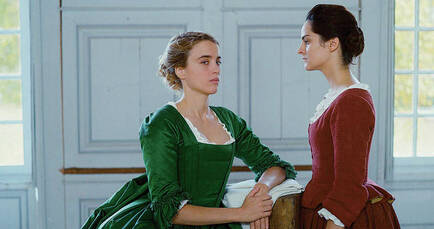Containing one other main speaking part, that of the castle’s young maid Sophie (Luana Bajrami), Portrait of a Lady on Fire has the appearance of a spare and austere film, wherein the action is going to take place on one stony location between a handful of characters in their period dress without scoring of any kind. That all makes the film feel timeless, while its subject matter and tone are what make it feel current. The combination of icy expectations and passionate romance is transporting and hypnotic, like something Stanley Kubrick directed and Richard Linklater wrote. Sciamma and cinematographer Claire Mathon are impeccable and precise with shot after shot worthy of a museum, and the tone of the film is kept warm and rich with candlelight and camaraderie. It’s naturalism by way of formalism, and the overall best directing of 2019.
While Portrait of a Lady on Fire exists primarily in the space between Marianne and Heloise, the presence of Sophie is also important and leads to the film’s best scene. The trio form a kind of family unit that breaks down the rigid class structure that exists between them. An immaculate tableau in the castle’s kitchen finds Heloise cooking for the other two, despite her technically being in charge as a (nonvoting) member of the second estate. When they aren’t falling for each other, Marianne and Heloise take Sophie’s future into their hands, as the young woman’s in need of an abortion. The dark comedy of 18th century home abortion treatments is hilarious, but what they need is a midwife. One is found at a gathering of all the local women around a campfire, where they enact a harmonized chant amongst the several generations of peasantry. The chant itself is hypnotic, and the scene provides the film its title and serves as the point of no return for Marianne and Heloise. That Sciamma would make this hunt for an abortion so pivotal to the events of the film, to say nothing of the provocative framing of the abortion itself, brings the film into the present.
At the core of the Portrait of a Lady on Fire is the simple act of seeing a person, something basic but loaded with as much meaning as a person is willing to invest it with. Sciamma and Mathon include many long holds of close-ups or silhouettes, first for the utilitarian purpose of Marianne remembering Heloise’s face for her painting, and then for more intimate reasons. Not only does this give each actor opportunities to show off their control of fine facial muscles, but it turns something simple into something complex. The camera, representing a character watching, makes both the viewer and the character being watched uncomfortable at first, as it’s uncomfortable to be stared at and creates tension as to when Marianne’s going to get busted. As the characters get acclimated to each other and grow to tolerate or revel in the eyes of their lover, all that tension turns into affection and hope for the characters’ future, even as a prologue guarantees that this isn’t going to work out.
If one has to take long looks at an actor, it doesn’t hurt that they’re played by Merlant or Haenal. Because they’re going to be in emotionally naked close-ups for so much of the film, Sciamma asks a great deal of both, and both are amazing. The film is a feat of athleticism on their parts, such that having such a level of control over their bodies is hard to imagine. So much is communicated in looks and glances and bit lips and eye crinkles. The fact of an all-female cast and creative team is also noticeable in what the camera chooses to focus on. Marianne and Heloise fall in love with each other’s minds first, and their bodies’ fall further down the list based on Sciamma’s refusal to leer at her actors, even during the aftermath of sex scenes. Those scenes are even elided to further emphasize that the primary act of lovemaking for these two happens in their eyes, such that sketching and posing becomes the most erotic act of the film.
As if there wasn’t enough in Portrait of a Lady on Fire to chew on, Sciamma and Haenel ended a multi-year relationship before filming began, so Sciamma essentially watched behind the camera as her ex fell in love with another woman. There’s a lot going on here, in addition to the swooning romance and the unimpeachable filmmaking. As is typical of French films, the characters make a connection to what they’re going through with literature, in this case the myth of Orpheus and Euridice. The latter is freed from hell, on the condition that the former doesn’t turn and look at her walking behind him until they get back to safety. Orpheus can’t help himself, looks, and that’s the end of that. Marianne, speaking Sciamma’s dialogue, frames the story as a happy one despite its central separation. The memory of seeing Euridice and holding the picture of her in his mind was more valuable to Orpheus than time with her. Sciamma’s created a memory of her and Haenal’s relationship that will persist longer than the relationship itself inside a film that will surely outlive them all. A

 RSS Feed
RSS Feed